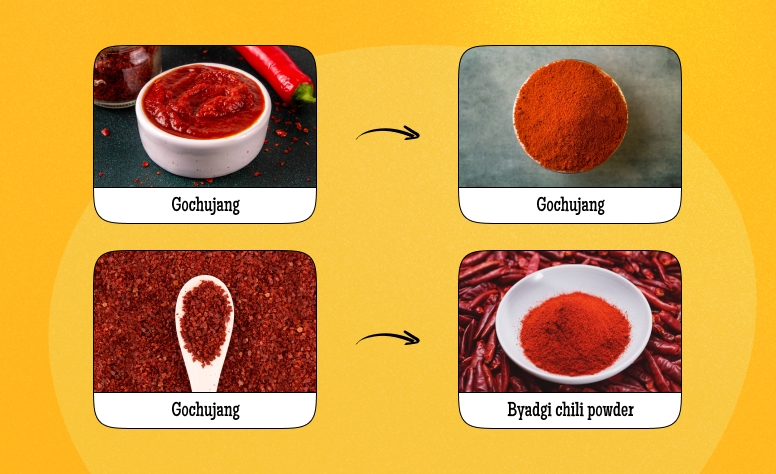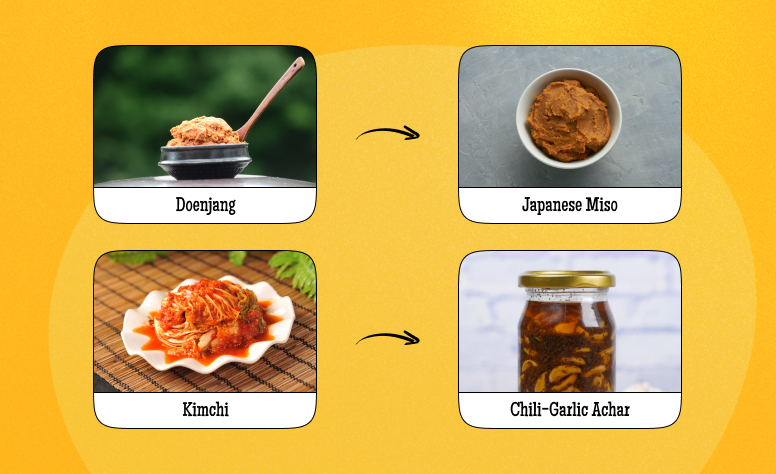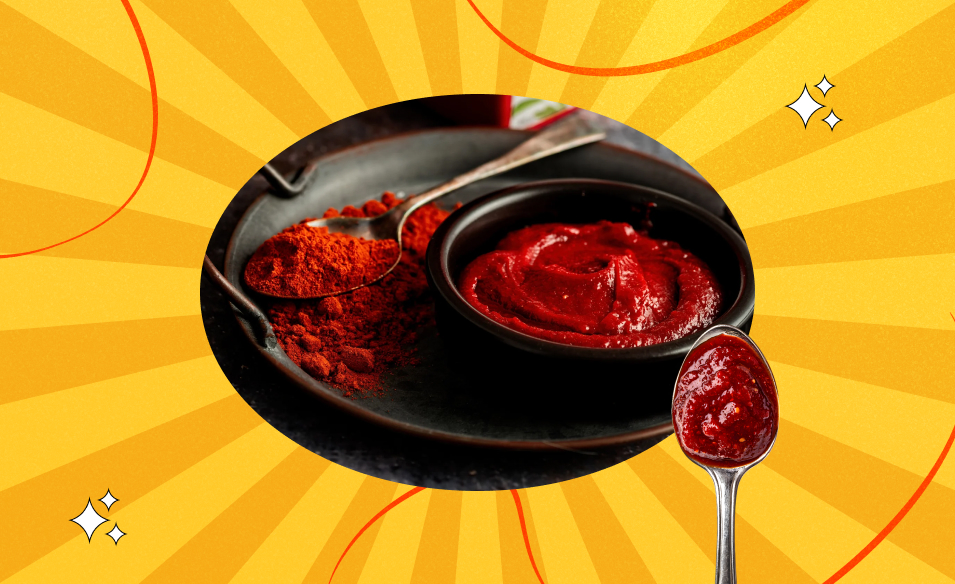Table Of Content
- What Are The Primary Koran Flavours You Need To Substitute?
- What Are Some Good Indian Substitutes for Korean Ingredients?
- Spice & Heat: Replacing Gochujang and Gochugaru
- Fermentation & Depth: Substituting Doenjang and Kimchi
- Umami Boosters: Replacing Dashima and Korean Soy Sauce
- Nutty Aromas: Replacing Sesame Oil
- Comforting Carbs: Korean Rice and Rice Cakes
- What Are Some Practical Cooking Scenarios With Substitutes?
- Can You Substitute Korean Ingredients With Indian Ones? Hell Yes!
I knew I was on board with Korean cuisine when I had my very first bite of toekbokki in my life.
I watched every video taht showcased steaming bowls of kimchi jjigae and vibrant plates of glossy tteokbokki, and I couldn’t resist the urge to try making them myself.
However, I quickly hit a roadblock. Most recipes called for ingredients that were nowhere to be found at my local Kirana store.
Gochujang, gochugaru, and doenjang sounded intriguing. But in Kolkata, they felt more like a treasure hunt than an easy cooking adventure.
Like many others diving into the world of Korean cuisine here in India, I turned to familiar Indian pantry staples and began to experiment.
Much to my delight, some combinations worked surprisingly well! This journey inspired me to create this guide.
I will focus on people who love Korean food but face challenges in cooking it with ingredients found in an Indian kitchen.
My goal is to help them do this while keeping the delicious authenticity of the dishes.
What Are The Primary Koran Flavours You Need To Substitute?
To recreate Korean dishes successfully, you need to know the five flavor pillars of Korean cuisine.
Keeping these in mind makes substitution easier, because you’re not just swapping ingredients — you’re replicating a flavor experience.
1. Spicy Heat – usually from gochujang and gochugaru.
2. Fermented Depth – from doenjang, kimchi, and fermented sauces.
3. Umami – boosted by kelp, anchovy broth, and soy sauce.
4. Nutty Aroma – sesame oil is key.
5. Comforting Carbs – short-grain rice and rice cakes.
What Are Some Good Indian Substitutes for Korean Ingredients?
Now that we have a good knowledge of all the primary flavors, it’s time to get started.
Spice & Heat: Replacing Gochujang and Gochugaru

You can substitute Gochujang (fermented chili paste) with Kashmiri red chili powder. To this, you have to add jaggery and a splash of soy sauce.
The Kashmiri chili gives color without too much heat. Additionally, you add the jaggery to balance the sweetness, and soy sauce brings umami.
Then, you can substitute Gochugaru (Korean chili flakes) with Byadgi chili powder if you want smokiness.
Or, you can use Kashmiri chili powder for a milder, vibrant red.
Why this works: According to the Journal of Food Science and Technology, Indian chilies like Kashmiri and Byadgi are studied for their carotenoid compounds.
Fermentation & Depth: Substituting Doenjang and Kimchi

You can substitute Doenjang (fermented soybean paste) with a mix of Japanese miso (available in Indian gourmet stores like Nature’s Basket) with a bit of tamarind pulp for the extra earthy tang.
Make a “kimchi-inspired achar” using cabbage, garlic, ginger, Kashmiri chili, and a short fermentation process.
You can also try fermented Indian pickles like chili-garlic achar as a quick stand-in.
Why this works: Both tamarind and Indian pickles mimic the layered sour-umami complexity of Korean ferments.
The Journal of Ethnic Foods even highlights parallels between kimchi fermentation and Indian achar traditions.
Umami Boosters: Replacing Dashima and Korean Soy Sauce

If kelp isn’t available, try nori sheets or even a pinch of Ajinomoto (MSG), which contains glutamates similar to kelp’s natural umami.
with light soy sauce from brands like Kikkoman or Chings. Avoid dark soy, as it’s too sweet and heavy for Korean soups and stews.
Why this works: According to FAO studies, MSG replicates the same umami compound present in kelp.
At the same time, light soy sauces are chemically closer to ganjang than the darker Indian-Chinese versions.
Nutty Aromas: Replacing Sesame Oil

Korean sesame oil → Use gingelly oil (nallennai) from Tamil Nadu or cold-pressed til oil available across India.
Why this works: South Indian gingelly oil is toasted and aromatic, almost identical to Korean sesame oil.
The Indian Journal of Traditional Knowledge documents its long-standing use for flavor and health, making it an authentic swap.
Comforting Carbs: Korean Rice and Rice Cakes

You can easily substitute short-grain Korean rice with Sona Masuri. This is a local rice from Andhra/Telangana.
Additionally, you can also go for Ambemohar, from Maharashtra. Both are soft and slightly sticky, unlike basmati.
Also, if you are looking for a substitute for Tteok (rice cakes), try South Indian rice cakes (idli batter steamed and sliced).
Additionally, you can use homemade rice flour dough, cut into cylindrical pieces. While not identical, they provide a chewy base for tteokbokki.
Why this works: According to the Indian Council of Agricultural Research (ICAR), Sona Masoori and Ambemohar have lower amylose levels. This gives them a sticky texture closer to Korean rice.
What Are Some Practical Cooking Scenarios With Substitutes?
Kimchi Jjigae with Indian ingredients → Use homemade cabbage achar for kimchi, miso+tamarind for doenjang, and light soy for ganjang.
Tteokbokki at home → Replace tteok with sliced steamed idli, coat with Kashmiri chili paste + jaggery mix for a gochujang effect.
Bibimbap in India → Use Sona Masoori rice, gingelly oil, and your chili paste substitute for gochujang sauce.
This approach makes Korean meals doable even when you can’t access specialty stores.
| Korean Ingredient | Indian Substitute | When to Use | Notes |
|---|---|---|---|
| Gochujang | Kashmiri chili + jaggery + soy | Sauces, marinades | Add rice flour slurry for thickness |
| Gochugaru | Kashmiri/Byadi chili powder | Kimchi, soups | Kashmiri = mild, Byadgi = smoky |
| Doenjang | Miso + tamarind | Stews, soups | Tamarind gives earthiness |
| Korean Soy Sauce | Light soy sauce | Soups, bibimbap | Avoid dark soy |
| Sesame Oil | Gingelly oil | Finishing oil | Cold-pressed for the best aroma |
| Dashima | Nori sheets / MSG | Broth | Use sparingly |
| Korean Rice | Sona Masoori / Ambemohar | Daily meals | Sticky texture closer to Korean rice |
| Tteok | Idli slices/rice dough | Tteokbokki | Texture substitute, not flavor |
Can You Substitute Korean Ingredients With Indian Ones? Hell Yes!
Korean ingredients are becoming more available in India through online markets, but knowing the best Indian substitutes makes it easier to start cooking right away.
From using Kashmiri chili powder in kimchi to swapping sesame oil with gingelly oil, these adaptations allow you to capture the soul of Korean flavors in an Indian kitchen.
If you’re a first-time cook of Korean food in India, don’t wait until you have the “perfect” ingredients.
Start with these substitutes, and you’ll realize that fusion is part of the fun — sometimes your Indian-Korean hybrid dishes might even taste better than expected.












